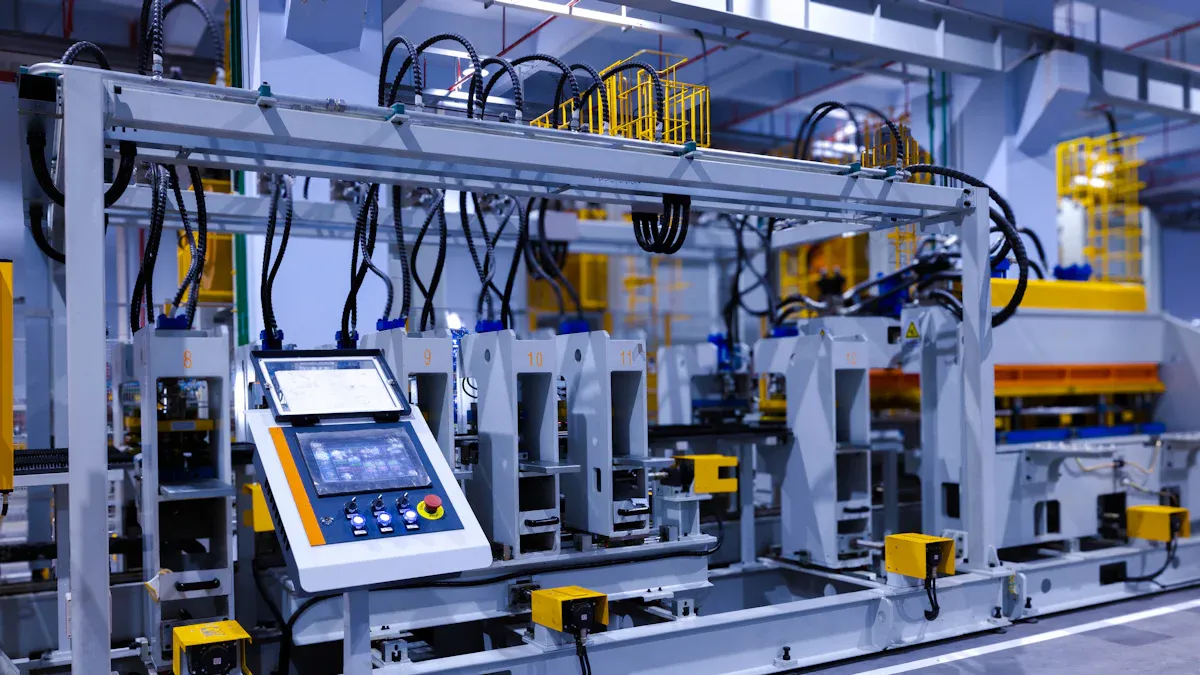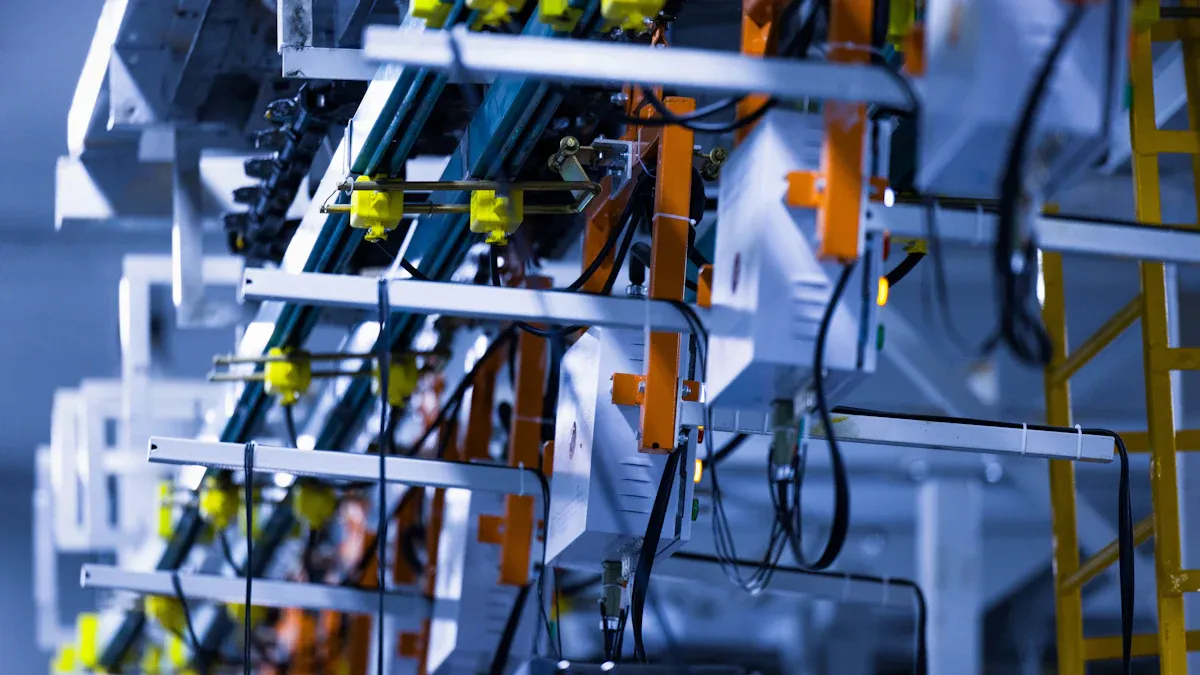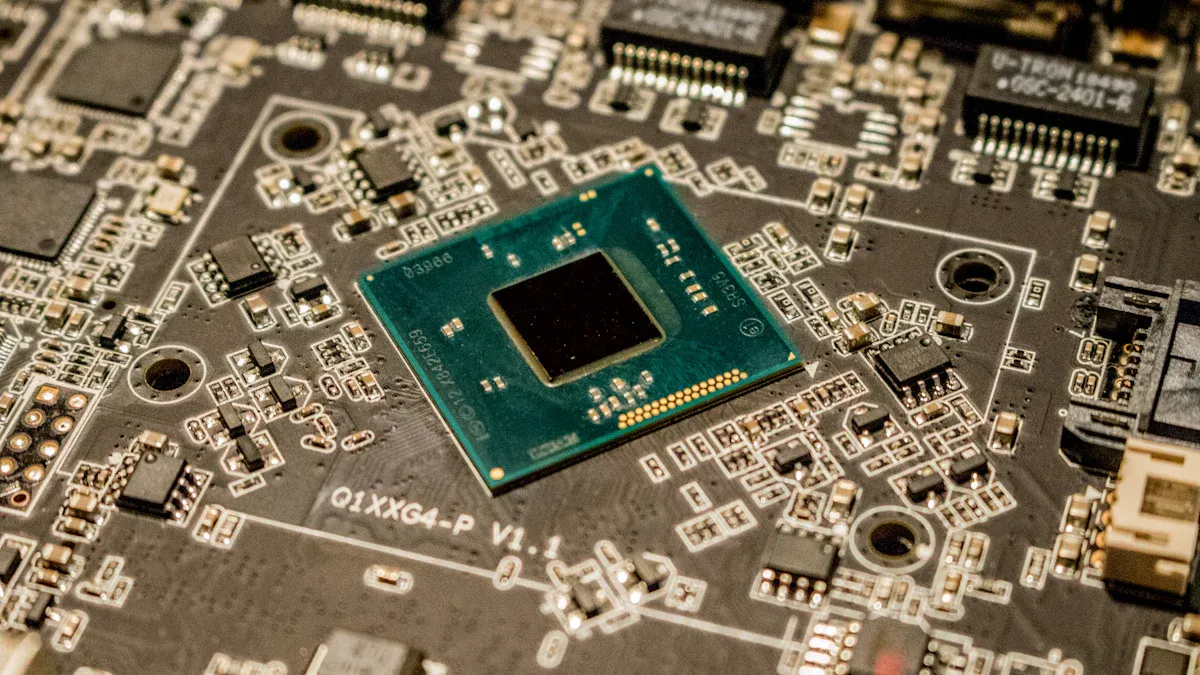
Mixed technology PCBA manufacturing uses two methods: SMT and THT. This mix lets you use many types of parts. It helps make strong and reliable circuit boards. SMT parts are small, light, and cost less. THT parts are stronger for parts that face stress. Some parts only come in certain styles, so both methods are needed. Using both methods makes designs flexible and fits modern electronics’ needs.
Key Takeaways
Mixed technology PCBA uses SMT and THT to make durable circuit boards.
Combining SMT and THT helps create flexible designs for modern devices.
Quality checks are important to keep performance and reliability high.
This method saves money while being fast and strong for all sizes.
Mixed technology PCBA works well in fields like cars, planes, and medicine.
What Is Mixed Technology PCBA Manufacturing?
Definition and Overview
Mixed technology PCBA manufacturing uses SMT and THT together. SMT places parts on the PCB’s surface. THT puts parts through holes and solders them. This mix lets you use parts of different sizes and shapes in one PCB.
PCB assembly has changed a lot over time. For example:
In the 1960s, integrated circuits (ICs) allowed multi-layer boards.
In the 1980s, SMT made assembly faster and better.
Today, rigid-flex PCBs and dense circuits are used in gadgets and electric cars.
Mixed technology PCBA builds on these changes, making it great for modern electronics.
Key Features of Mixed Technology Assembly
Mixed technology assembly has special features that improve PCB making:
Key Features of Mixed Technology PCBA Manufacturing | Description |
|---|---|
Single Side Mixed Assembly | Small THT parts are soldered by hand. |
One Side SMT & One Side THT | Costs more and is harder to solder. |
Double Side Mixed Assembly | Glue use changes cost and efficiency. |
Hand Soldering vs. Wave Soldering | More SMT parts mean more hand soldering. |
These features let you adjust the process for your needs. For example, double-sided assembly works for complex designs. Single-sided assembly is better for simple ones.
Importance of Combining SMT and THT
Using both SMT and THT is key for today’s electronics. SMT parts are small and light, good for tight spaces. THT parts are strong and handle stress well.
Some parts only come in certain styles, like high-power parts for electric cars or flexible PCBs for tough conditions. Using both SMT and THT makes PCBs that are strong, reliable, and cost-friendly. It also helps with eco-friendly practices like recycling and using green materials.
Mixed technology assembly makes PCBs flexible and useful for many industries.
How Does Mixed Technology PCBA Manufacturing Work?
Step-by-Step Process
The mixed technology PCBA process has many steps for quality results. Each step is important to make a strong and efficient PCB. Here’s how it works:
Design and Component Selection: First, design the PCB layout and pick parts. This step ensures the design fits the product’s needs.
PCB Fabrication: The PCB is made based on the design. This includes adding layers, traces, and holes.
SMT Assembly: Machines place small SMT parts on the PCB surface. These machines ensure parts are placed and soldered correctly.
THT Assembly: Larger THT parts go into drilled holes on the PCB. These parts are soldered by hand or with wave soldering.
Inspection and Testing: After assembly, the PCB is checked and tested. Tests make sure it works well in different conditions.
Metric | Description |
|---|---|
Counts defects per million chances, showing quality levels. | |
First Pass Yield (FPY) | Percent of PCBs passing all tests the first time. |
Rework Rate | Percent of PCBs needing fixes after assembly. Lower rates mean better quality. |
Scrap Rate | Percent of unusable PCBs due to defects. Lower rates mean higher productivity. |
Testing checks power, inputs/outputs, communication, and stress handling. These steps ensure the PCB is reliable and high-quality.
Integration of SMT and THT Components
Using both SMT and THT parts in one PCB needs careful planning. SMT parts are great for small designs, while THT parts are strong and durable. Follow these steps to combine them:
Component Selection and Inspection: Pick good parts to avoid problems during assembly.
PCB Preparation: Check the PCB for flaws before starting assembly.
Process Control: Keep the assembly process steady for consistent quality.
Soldering Techniques: Use wave soldering for THT and reflow soldering for SMT parts.
Inspection and Testing: Use tools like X-rays to find hidden defects.
By combining SMT and THT, you can make flexible and powerful PCBs. This method works for small gadgets and tough industrial machines.
Quality Assurance in Mixed Technology Assembly
Quality checks are key in mixed technology assembly. Strict steps ensure the final product works well. Industry rules like IPC-A-610 and IPC-J-STD-001 guide quality checks. These rules cover part placement, soldering, and inspections.
To keep quality high:
Make sure workers are trained and certified in IPC standards.
Use advanced tools like X-rays to find defects.
Test the PCB in tough conditions to check its performance.
By doing these, you can make reliable and high-quality PCBs. Mixed technology PCBA combines accuracy, flexibility, and scalability, making it perfect for modern electronics.
Unique Features of Mixed Technology PCBA Manufacturing

Accurate Component Placement
Mixed technology PCBA places parts on PCBs with great care. SMT parts are added by machines, ensuring tiny parts fit perfectly. Through-hole parts are placed by hand or special tools for proper alignment. This mix reduces mistakes and makes the final product more reliable.
This accuracy is crucial for modern electronics. Small errors can cause big problems. Machines in SMT reduce human mistakes. Careful placement of through-hole parts adds strength to handle stress. Together, these methods make PCBs both precise and strong.
Flexible Design and Functionality
Mixed technology PCBA allows creative and flexible PCB designs. Rigid-flex PCBs combine stiff and bendable parts for unique shapes. These are great for small devices like smartwatches and IoT gadgets.
Stiff parts hold important components securely.
Bendable parts handle stress and fit tight spaces.
Designers must plan carefully for strength and durability.
Flexibility also means thinking about how often the PCB will bend. This ensures it lasts a long time. Mixed technology PCBA helps create designs that work well mechanically and electrically.
Scalable for Different Production Needs
Mixed technology PCBA works for both small and large projects. It’s good for prototypes and mass production. SMT speeds up making many PCBs, while through-hole parts are used for stronger designs.
You can adjust production easily with this method. Machines handle SMT for big orders, and hands-on work is used for through-hole parts. This makes mixed technology PCBA perfect for industries like electronics and aerospace. It keeps costs low and quality high, no matter the project size.
Advantages of Mixed Technology PCBA Manufacturing
Better Performance and Strength
Mixed technology PCBA makes devices work better and last longer. It uses both SMT and through-hole parts. SMT parts save space and make designs efficient. Through-hole parts add strength for tough conditions. Together, they create strong and reliable PCBs.
This mix helps build high-quality devices for hard environments. SMT parts allow small, detailed designs. Through-hole parts handle stress and stay strong. This balance is great for industries like cars, planes, and medical tools.
Feature | |
|---|---|
Stronger Design | Through-hole parts add durability to the PCB. |
Space-Saving Designs | SMT parts make compact and efficient layouts. |
Reliable Performance | Works well in tough and complex situations. |
Combines fast SMT with strong through-hole assembly. |
This method ensures your PCBs are strong and work perfectly.
Saves Money for Complex Designs
Mixed technology PCBA is a smart way to save money. SMT uses machines, which lowers labor costs and speeds up work. Through-hole parts take more time but add needed strength. Using both methods balances cost and quality.
This process also reduces waste. SMT uses fewer materials by making small designs. Through-hole parts last longer, so fewer replacements are needed. This saves money for both small and big projects.
Works with New Technologies
Mixed technology PCBA supports modern tech needs. It combines parts like sensors, chips, and power modules on one PCB. This makes it perfect for advanced devices.
For example, in IoT gadgets, SMT parts keep designs small. Through-hole parts add strength for connectors and power supplies. This mix works for many industries, like home electronics and factory machines.
Using mixed technology helps make PCBs that are smart, strong, and useful. It’s a top choice for engineers and makers everywhere.
Applications of Mixed Technology PCBA Manufacturing

Automotive and Transportation Systems
Mixed technology PCBA is key in car electronics. It’s used in electric cars, driver-assist systems, and emission controls. These systems need small, strong PCBs to handle power and complex tasks.
The car industry uses more mixed technology PCBA as electronics grow. For example, over 40 million electric cars are expected by 2024. This is a big jump from less than 200,000 in 2012. This shows the need for PCBs that work with electric engines and self-driving tech.
Mixed technology PCBA makes durable and precise PCBs for cars. It uses SMT for small designs and THT for strength. This ensures car electronics work well under stress.
Aerospace and Defense Applications
Aerospace and defense need high-quality PCBs. Mixed technology PCBA is used in planes, radars, and communication tools. These systems need to be exact, reliable, and work in tough conditions.
The defense field benefits from mixed technology PCBA as budgets and tech improve. For instance, reliable PCBs are crucial for satellites and military gear. Mixed technology combines SMT for small parts and THT for strong connections.
This method helps make advanced aerospace and defense tools. It ensures devices work perfectly in hard environments.
Consumer Electronics and IoT Devices
Mixed technology PCBA helps make better gadgets and IoT devices. It’s found in phones, wearables, and smart home tools. These need small, light PCBs with many features.
New ideas in electronics increase the need for mixed technology PCBA. SMT parts make smaller designs, while THT parts add strength for connectors and power. This mix makes devices efficient and long-lasting.
Application Segment | Key Drivers |
|---|---|
Consumer Electronics | New designs, demand for phones, tablets, wearables, and better PCBs. |
Automotive | More electronics, driver-assist systems, electric engines, and lower emissions focus. |
Aerospace & Defense | High-quality needs, tech growth, and bigger defense budgets. |
Mixed technology PCBA helps make smarter and more useful electronics. It supports the growing complexity of modern devices.
Medical Equipment and Devices
Medical tools need to be precise and reliable. Mixed technology PCBA helps make circuit boards for devices like heart monitors and imaging machines. These tools need top-quality parts for accurate and dependable performance.
Mixed technology PCBA is useful for medical device design. SMT makes small designs, perfect for portable tools. THT adds strength, making devices last longer in hospitals or clinics. Using both methods ensures your equipment meets strict health standards.
Advanced features in medical devices rely on mixed technology PCBA. SMT allows sensors and microprocessors for real-time data tracking. THT strengthens power supplies and key parts. This mix ensures devices work well in tough conditions.
Tip: Choose parts that meet rules like ISO 13485. This ensures your devices are safe and high-quality.
Mixed technology PCBA also saves money. SMT speeds up production, while THT makes devices stronger, reducing repairs. This balance keeps costs low without losing quality.
Medical devices often face harsh conditions. Mixed technology PCBA helps them handle temperature changes, vibrations, and moisture. This makes it great for use in ambulances, operating rooms, and remote clinics.
By using mixed technology PCBA, you create small, strong, and reliable medical devices. This method supports healthcare innovation, helping patients and providers with better solutions.
Mixed technology PCBA is important for today’s electronics. It uses SMT and THT to make strong, flexible circuit boards. This method helps create advanced designs and dependable devices.
AI, IoT, and new tech are changing the semiconductor industry.
People want smaller, tougher devices, boosting PCB demand.
Making things smaller and smarter improves quality and saves time.
By 2025, focus will be on smart, eco-friendly, and advanced PCBs.
As tech grows, mixed technology assembly will stay key for innovation.
FAQ
What is the main benefit of mixed technology PCBA manufacturing?
Mixed technology PCBA uses both SMT and THT methods. This lets you combine small, light parts with strong, durable ones. It creates circuit boards that are compact and tough, perfect for modern devices.
How does mixed technology PCBA improve product reliability?
Using SMT adds precision, while THT adds strength. Together, they make circuit boards that work well under stress. This reduces failures and makes products reliable for tough uses like cars or airplanes.
Can mixed technology PCBA handle small production runs?
Yes, mixed technology PCBA works for small and big projects. SMT machines make mass production fast. THT allows manual changes for prototypes. This makes it great for different project sizes.
Why is quality assurance important in mixed technology PCBA?
Quality checks ensure your circuit boards meet standards and work well. Inspections, tests, and rules like IPC-A-610 help keep quality high. These steps make sure your products are reliable and meet customer needs.
What industries benefit most from mixed technology PCBA?
Industries like cars, planes, gadgets, and healthcare use mixed technology PCBA. It supports advanced designs for electric cars, smart devices, medical tools, and more. It offers the flexibility and strength these industries need.
Tip: Pick a skilled manufacturer in mixed technology PCBA for the best results.
See Also
Understanding PCBA Manufacturing And Its Significance Today
The Importance Of Tailored PCBA Manufacturing In Electronics
Benefits And Challenges Of Flex PCBA In Electronics